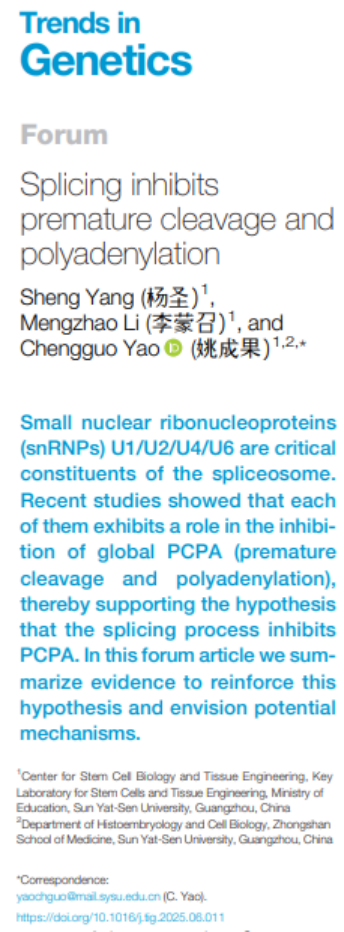Trends in Genetics | The Yao Chengguo research group of our hospital proposed the universal theory of splicing inhibition of premature mRNA3’ terminal processing and transcription termination
The classic molecular biological function of the five pre-mRNA splicing core snRNP complexes (U1, U2, U4, U5, U6) is the eukaryotic pre-mRNA splicing function described in biochemistry textbooks. In 2024 and 2025, the research group of Professor Chengguo Yao from our institute and the research group of Professor Congting Ye from Xiamen University successively published papers in the internationally renowned journals PNAS (https://pubmed.ncbi.nlm.nih.gov/38917004/) and Cell Reports (https://pubmed.ncbi.nlm.nih.gov/40019833/). These papers reported that, similar to U1 snRNP, U4/U6/U2 snRNP can inhibit premature transcription termination in the transcriptome, thereby maintaining the universality of the integrity of full-length pre-mRNA transcription. This systematic research result suggests that the splicing process has a new function of inhibiting premature transcription termination, which has important theoretical guiding significance in the study of the molecular mechanism of mRNA cotranscriptional processing.
On July 11, the research group of Professor Chengguo Yao from the Stem Cell Center of our institute was invited to publish a Forum article entitled "Splicing inhibits premature cleavage and polyadenylation" in Trends in Genetics (a Cell sub-journal, CAS Tier 1, IF=16.3), a top review journal in the field of genetics, formally putting forward the above theory. The paper comprehensively summarizes the recent research progress on the new functions of U1/U2/U4/U6 snRNP, and discusses the advantages of the theory that splicing inhibits PCPA (premature cleavage and polyadenylation) and PTT (premature transcription termination). For example, under this theoretical framework, the processing of thousands of potential PAS (cryptic polyadenylation sites) becomes the core connecting post-transcriptional regulation and transcriptional regulation. This may provide explanations for many phenomena in the study of the molecular mechanism of mRNA cotranscriptional processing, such as RNAPII promoter-proximal pausing, RNA binding proteins functioning in transcription regulation, and so on.
Furthermore, the authors propose possible molecular mechanisms by which splicing inhibits PCPA and PTT, mainly divided into the kinetic inhibition model and the direct hindrance model. In conclusion, this paper formally puts forward a universal new concept in the field of research on the molecular mechanism of mRNA cotranscriptional processing, providing new ideas and development directions for further research in the future.

Yang Sheng, a graduate student of our institute, is the first author of the paper, and Professor Chengguo Yao of our institute is the sole corresponding author. The research was supported by a number of funds, including the General Program of the National Natural Science Foundation of China and the General Program of the Natural Science Foundation of Guangdong Province.
Original article link: https://www.sciencedirect.com/science/article/pii/S0168952525001623.


